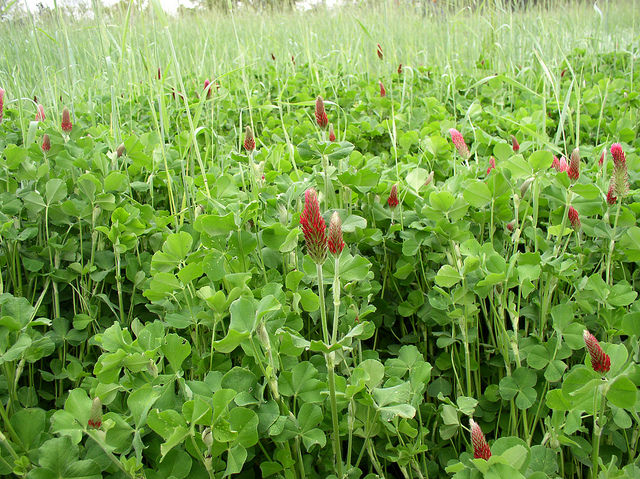
Over the last decade, the U.S. Department of Agriculture’s (USDA) Conservation Stewardship Program (CSP) has enrolled over 94 million acres of farmland, ranchland, and forestland in conservation contracts. As of the end of 2018, over 74 million acres were enrolled in active CSP contracts – a landmass equal to the entire size of the states of Iowa and Georgia combined. As the largest conservation program in the country, CSP provides much needed conservation assistance to producers and landowners with agricultural lands in production and promotes sustainable farming methods that work in concert with the environment.
The National Sustainable Agriculture Coalition (NSAC) recently published a new Special Report based on the latest available data, which analyzes CSP’s contribution to conservation-minded producers and landowners. In addition to enrollment, renewal, and land use trends, the Special Report presents a deep dive analysis on the use of various conservation practices and enhancements across the country, as well as CSP’s critical role in supporting conservation efforts across diverse farmer groups.
CSP Background
CSP is not only USDA’s largest working lands conservation program, its comprehensive approach to conservation assistance also makes it unique. Producers enroll their entire operation as part of a CSP contract, and are rewarded not only for implementing new and more advanced conservation activities, but also for actively managing and maintaining existing stewardship practices. The program provides much more than the more typical “one and done” a la carte approach to conservation, recognizing the need for a more ongoing, comprehensive approach to conservation assistance. Conservation activities available for support through CSP are designed to increase the long-term sustainability of agricultural operations, while also enhancing soil health and protecting natural resources.
CSP recognizes what all farmers know well, that comprehensive conservation requires long-term investment. In order to sustain conservation support over time, CSP offers producers five year contracts, as well as a renewal opportunity at the end of each contract period (provided they have fulfilled the terms of the previous contract and commit to continual improvement). CSP contract holders receive annual payments that reflect their success in actively managing ongoing, as well as newly adopted, conservation activities.
Report Highlights
CSP’s Footprint
This Special Report confirms that CSP’s footprint continues to be quite significant. Per 2018 enrollment data, the program covered over 8 percent of total farmland within the United States, and 18 states had 10 percent or more of their total agricultural land enrolled in the program. This report also highlights considerable state to state variability of total farmland enrolled in CSP, suggesting that CSP enrollment is dependent on state and local offices’ engagement and promotion of the program. The map below highlights the state to state variability in how much farmland within a state is enrolled in CSP, suggesting that states with higher engagement, well-trained field staff, and more robust outreach strategies at the state and local level enroll more acres in CSP. It is instructive, for instance, to compare Vermont with New Hampshire, North Carolina with South Carolina, Iowa with Minnesota, or Arizona with New Mexico.
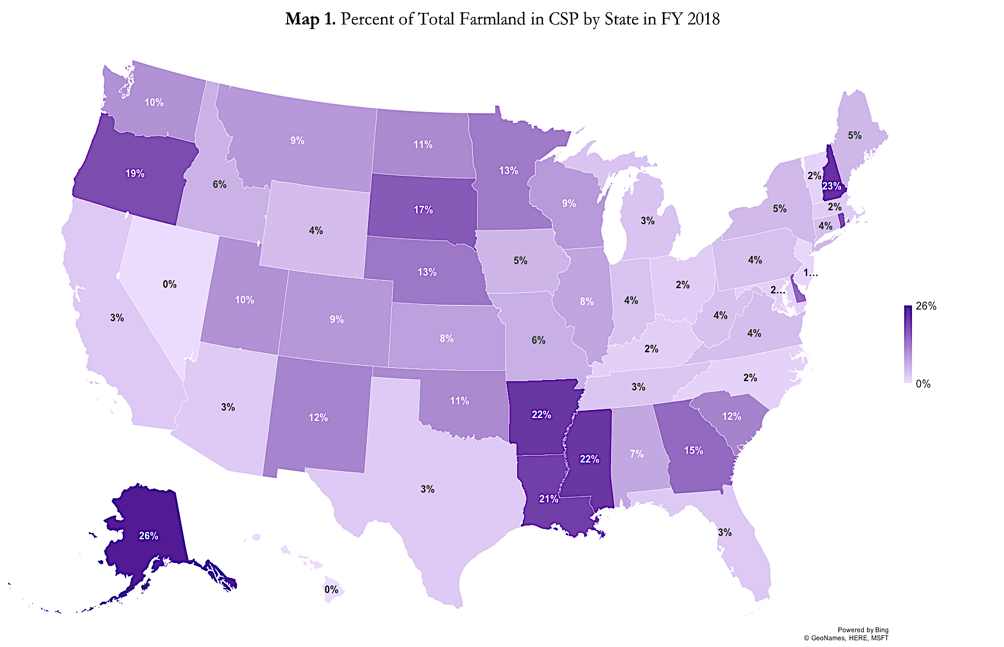
Conservation Practices and Enhancements
Analysis of conservation practices and enhancements revealed that significant acres were devoted to addressing water quality concerns, as well as soil erosion and soil quality degradation. The top five conservation practices in terms of acreage as of 2018 were: integrated pest management (IPM), cover crops, prescribed grazing, nutrient management, and conservation crop rotation. All of these practices address multiple resource concerns and represent a strong water quality and soil health focus within CSP. The top enhancements (including those related to precision agriculture, IPM, grazing and forage management, and conservation tillage) shared that same focus.
Four of the top five enhancements as of 2018 were related to the IPM and nutrient management conservation practices and sought to address water quality concerns, including reducing risk of pesticides in surface water and improving nutrient uptake efficiency to reduce nutrient losses to surface water. Nutrient loss prevention and reduction enhancements and soil health enhancements were top of the list of enhancements across the country as of 2018.
In 2018 alone, over $27 million was invested in the top five CSP conservation practices and their related enhancements, addressing water quality degradation, soil erosion, soil quality degradation, and degraded plant condition, among many other natural resource concerns. With five year contracts, the total contract amount for these practices and enhancements are several multiple times larger.
Enrollment and Renewals
Almost 8,000 farmers and ranchers across 49 states and Puerto Rico signed new CSP contracts in 2018. Mississippi far outpaced all other states in 2018 with 770 new enrolled participants, compared to 369 new contracts made in the state in 2017. Minnesota lost its 2017 rank of number one and dropped to number four in 2018.
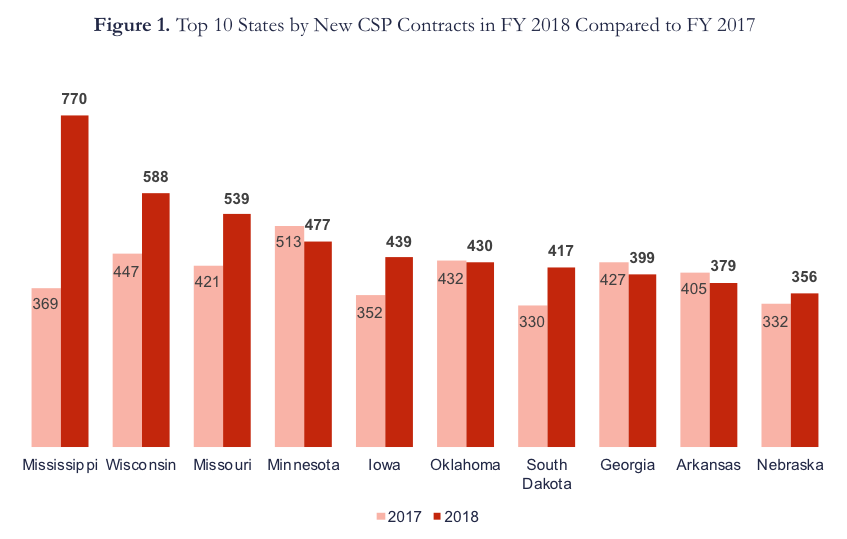
However, the states with the highest number of new CSP acres in 2018 are not the same as those with the most contracts. This difference is reflective of the diversity of operation sizes across the country, with certain states being more suitable to larger operations than others. For example, South Dakota, home to many large acreage ranching operations, topped the list in terms of acres in 2018, enrolling more than 944,000 new acres. South Dakota saw a 43 percent increase in new acres from 2017 to 2018. The state now has over seven million acres enrolled in CSP, meaning that over 17 percent of the state’s agricultural land is enrolled in the program.
An area of concern uncovered by this report is a major drop in renewals. The CSP contract renewal rate in 2017 was nearly 60 percent compared to 38 percent in 2018. Additionally, only 46 percent of acres were renewed in 2018 compared to 77 percent in 2017. The reinvention of CSP prior to the 2017 sign-up period weakened the renewal process by lowering renewal payment rates, which very likely was a major contributor to the decline in renewals in 2018. Between 2015 and 2017 the CSP renewal rate average was 57 percent for contracts and 73 percent for acres, suggesting that the reinvention critically affected the renewal process. Arkansas, South Dakota, and Nebraska had the highest number of renewal contracts in 2018. At the far opposite extreme was Minnesota, which experienced the sharpest decrease in renewal contracts from 2017 to 2018. Despite a normal 66 percent of contracts renewed in 2017, Minnesota fell drastically to renewing only 19 percent of contracts in 2018.
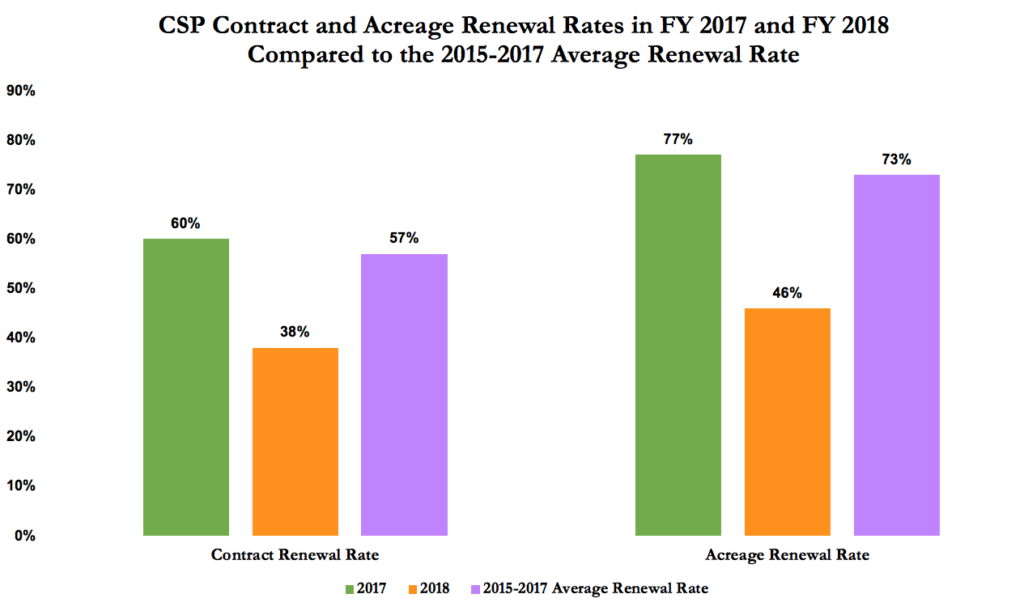
Beginning and Socially Disadvantaged Farmers and Ranchers
With respect to historically underserved producers, 16 percent of total CSP contracts and eight percent of acres were enrolled by beginning farmers and ranchers in 2018; whereas five percent of contracts and five percent of acres were enrolled by socially disadvantaged producers. The percent of total acres enrolled by beginning farmers and ranchers increased from 2017 to 2018, but the percent of total acres enrolled by socially disadvantaged farmers and ranchers decreased during this time period. While the legislative mandate of five percent of acres is being met, more work needs to be done to ensure that beginning and socially disadvantaged producers have equitable access to CSP.
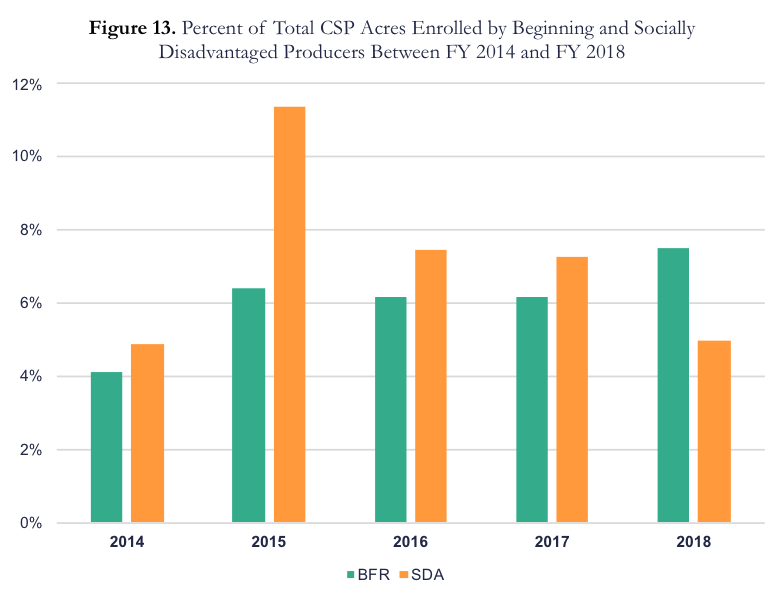
The Special Report includes maps showing the state to state variability of CSP acres enrolled by beginning and socially disadvantaged producers. The maps show, for example, that many states had at least five percent or more of their total CSP acres enrolled by beginning farmers and ranchers. Some states, however, had no acres enrolled by beginning producers in 2018, including Alaska, Florida, Nevada, Wyoming and several Northeastern states. Beginning farmers and ranchers make up a significant portion of agricultural producers in many of these states, so it is concerning that none of the CSP acres in these states in 2018 were enrolled by beginning farmers and ranchers.
Furthermore, although CSP acres enrolled by socially disadvantaged farmers nationally met the five percent set-aside requirement, a lot of variability exists from state to state. In 2018, states like New Mexico and Oklahoma had high percentages of CSP acres enrolled by socially disadvantaged producers, suggesting that Tribal communities are effectively engaging with USDA conservation programs. In other parts of the country, like much of the Corn Belt, we can expect low enrollments in CSP from socially disadvantaged producers given that these states tend to have smaller populations of farmers of color. However, it is concerning to see low enrollments in CSP by socially disadvantaged farmers across the Black Belt, where large populations of farmers of color are located. States like Mississippi, Alabama, North Carolina, and Florida can do more to inform and encourage farmers of color to participate in CSP.
Dig Deeper
To learn more about land use trends, conservation practice utilization across the country, and the changes made to the program in the 2018 Farm Bill, read NSAC’s latest Special Report. The report includes much more details on enrollment and renewal data, as well as maps and visual representations of NSAC’s key findings. This report highlights remarkable state to state variability, suggesting that CSP enrollment depends on state and local offices’ engagement and promotion of the program. NSAC concludes that greater accountability measures need to be put in place to encourage more uniformity in program adoption across the nation. We will continue to monitor and report on data as it becomes available.

